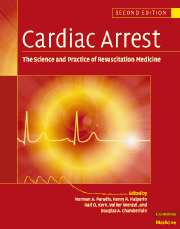Book contents
- Frontmatter
- Contents
- List of contributors
- Foreword
- Preface
- Part I Introduction
- Part II Basic science
- Part III The pathophysiology of global ischemia and reperfusion
- 12 The etiology of sudden death
- 13 Global brain ischemia and reperfusion
- 14 Reperfusion injury in cardiac arrest and cardiopulmonary resuscitation
- 15 Visceral organ ischemia and reperfusion in cardiac arrest
- 16 Mechanisms of forward flow during external chest compression
- 17 Hemodynamics of cardiac arrest
- 18 Coronary perfusion pressure during cardiopulmonary resuscitation
- 19 Methods to improve cerebral blood flow and neurological outcome after cardiac arrest
- 20 Pharmacology of cardiac arrest and reperfusion
- 21 Analysis and predictive value of the ventricular fibrillation waveform
- 22 Etiology, electrophysiology, and myocardial mechanics of pulseless electrical activity
- Part IV Therapy of sudden death
- Part V Postresuscitation disease and its care
- Part VI Special resuscitation circumstances
- Part VII Special issues in resuscitation
- Index
21 - Analysis and predictive value of the ventricular fibrillation waveform
from Part III - The pathophysiology of global ischemia and reperfusion
Published online by Cambridge University Press: 06 January 2010
- Frontmatter
- Contents
- List of contributors
- Foreword
- Preface
- Part I Introduction
- Part II Basic science
- Part III The pathophysiology of global ischemia and reperfusion
- 12 The etiology of sudden death
- 13 Global brain ischemia and reperfusion
- 14 Reperfusion injury in cardiac arrest and cardiopulmonary resuscitation
- 15 Visceral organ ischemia and reperfusion in cardiac arrest
- 16 Mechanisms of forward flow during external chest compression
- 17 Hemodynamics of cardiac arrest
- 18 Coronary perfusion pressure during cardiopulmonary resuscitation
- 19 Methods to improve cerebral blood flow and neurological outcome after cardiac arrest
- 20 Pharmacology of cardiac arrest and reperfusion
- 21 Analysis and predictive value of the ventricular fibrillation waveform
- 22 Etiology, electrophysiology, and myocardial mechanics of pulseless electrical activity
- Part IV Therapy of sudden death
- Part V Postresuscitation disease and its care
- Part VI Special resuscitation circumstances
- Part VII Special issues in resuscitation
- Index
Summary
Introduction: Why analyze the waveform?
Ventricular fibrillation (VF) is the cardiac arrest rhythm most amenable to successful treatment, and the vast majority of survivors from human cardiac arrest have VF as their primary rhythm. Successful treatment in these patients almost invariably requires electrical defibrillation. While advances have been made in defibrillation therapy, particularly in the introduction of automatic and semi-automatic defibrillators (AED) with rhythm recognition and the use of novel defibrillatory waveforms, the primary determinant of successful defibrillation is the duration of the VF episode. With the passage of time, the chances of successful defibrillation fall dramatically. Basic life support (BLS) procedures in general and myocardial perfusion due to closed-chest compression can only retard the metabolic deterioration of the myocardium. With prolonged duration of VF, an increasing likelihood of asystole, pulseless electrical activity, or persistent VF following countershock results. Moreover, multiple countershocks that do not result in spontaneous circulation are probably harmful by causing thermal damage to the heart and increasing cumulative defibrillation energy decreases postresuscitation myocardial function and survival.
For these reasons, researchers attempt to interrogate the VF waveform determined from the surface electrocardiogram (ECG) trace to ascertain knowledge of the myocardial state, to assess the probability of success of a defibrillating shock, and to investigate whether, by physical or pharmacological means, the situation can be changed to improve the likelihood of restoring a spontaneous perfusing rhythm.
Data acquisition and preprocessing
Logistic difficulties
Although the primary focus of analysis is the ECG-derived VF waveform itself, additional documentation such as patient demographics, electrical, pharmacological, and physical interventions, and outcome information is required to provide meaningful conclusions.
- Type
- Chapter
- Information
- Cardiac ArrestThe Science and Practice of Resuscitation Medicine, pp. 417 - 425Publisher: Cambridge University PressPrint publication year: 2007



